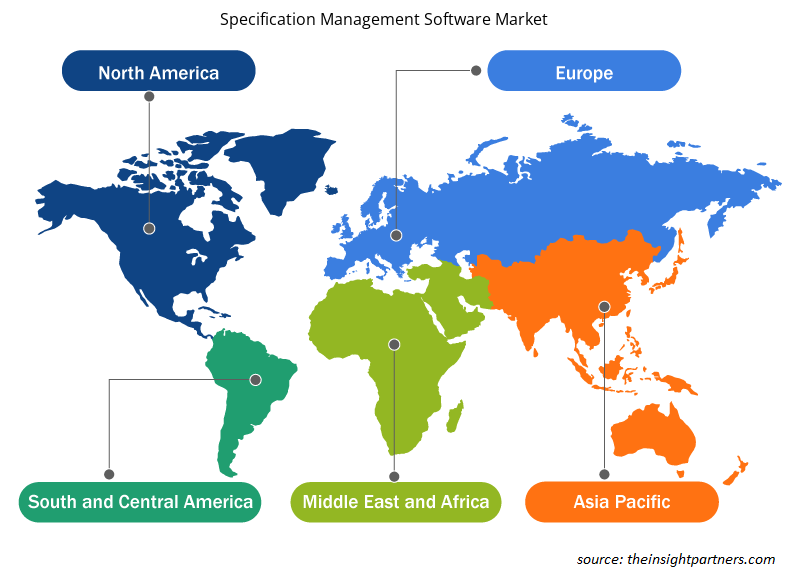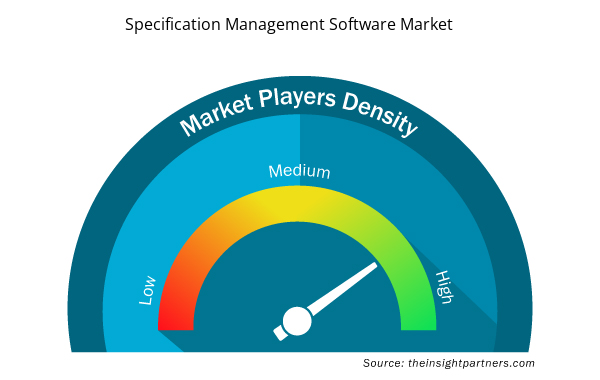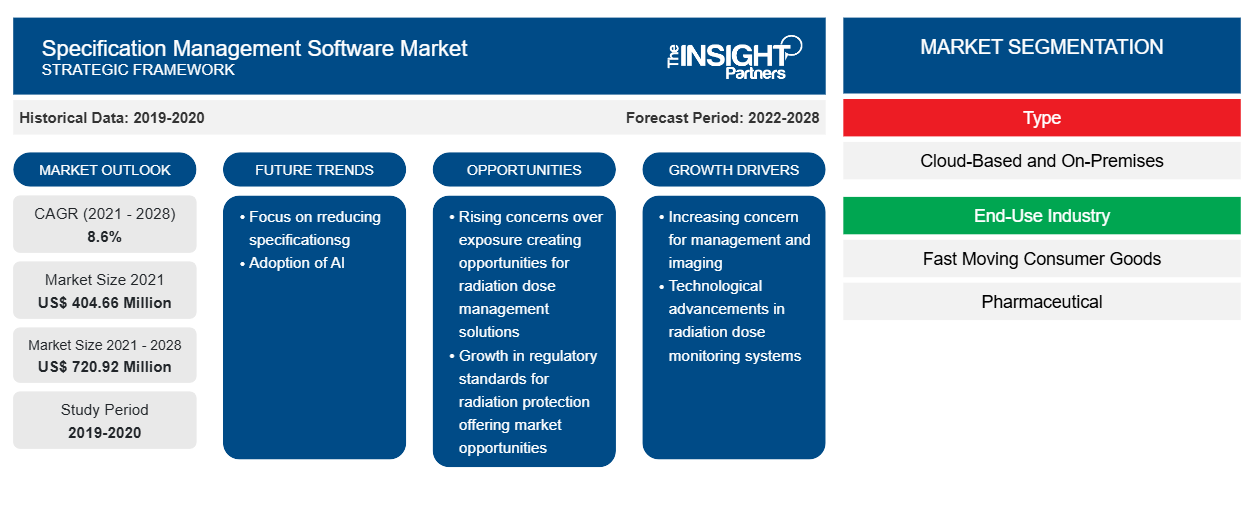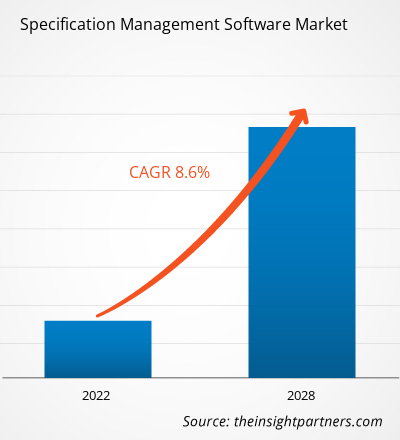من المتوقع أن ينمو سوق برامج إدارة المواصفات من 404.66 مليون دولار أمريكي في عام 2021 إلى 720.92 مليون دولار أمريكي بحلول عام 2028؛ ومن المتوقع أن ينمو بمعدل نمو سنوي مركب قدره 8.6٪ خلال الفترة 2021-2028.
يتم تصنيع المنتجات الصيدلانية عن طريق الجمع بين أنواع مختلفة من المواد الكيميائية أو المواد البيولوجية. تتضمن عملية التصنيع مجموعة من عمليات الوحدة، بما في ذلك التحبيب والملء والمزج والطحن وضغط الأقراص والطلاء. يحتاج المصنعون إلى الالتزام باللوائح المحددة واتباع الإرشادات المناسبة للحفاظ على الكمية الدقيقة من المواد الكيميائية والحفاظ على جودتها. يجب تشغيل المعدات المشاركة في تصنيع الأدوية وصيانتها وفقًا لممارسات التصنيع الجيدة ( GMP ). مع الارتفاع المستمر في الطلب على الأدوية / العقاقير في جميع أنحاء العالم، تستثمر شركات الأدوية بشكل كبير في تنفيذ حلول تكنولوجيا المعلومات المختلفة في عمليات مختلفة. على سبيل المثال، يتم اعتماد برنامج إدارة المواصفات للمواصفات الدقيقة والدقيقة للمواد الكيميائية المستخدمة في تصنيع الأدوية؛ وهذا يساعد شركات الأدوية على ضمان الجودة وكذلك الامتثال التنظيمي عبر سلسلة القيمة بأكملها في الصناعة.
تؤثر سلاسل التوريد المعقدة واللوائح الصارمة وقضايا سلامة البيانات على استراتيجيات الجودة والعمليات في صناعة الأدوية. تركز إدارة الغذاء والدواء والسلطات المماثلة الأخرى بشكل صارم على الامتثال التنظيمي من قبل شركات الأدوية، وبالتالي ضمان الحفاظ على معايير الجودة في جميع أنحاء صناعة الأدوية العالمية. تسمح بيانات برنامج إدارة المواصفات للمستخدمين بالحفاظ على مقاييس متسقة وحسابات المخاطر وتحليلات الاتجاهات الأخرى. تشمل وظيفة برنامج إدارة المواصفات إدارة المواد الخام وإدارة التركيبة والمكونات وإدارة التعبئة والتغليف وإدارة المستندات وإدارة الجودة. على سبيل المثال، تقدم Pilgrim Quality Solutions حلول SmartSolve Pharmaceutical QMS التي تتعامل بدقة ودقة مع إدارة المستندات وإدارة المنتجات غير المطابقة للمواصفات وإدارة الاستدعاء وإدارة جودة الموردين وما إلى ذلك.
قم بتخصيص هذا التقرير ليناسب متطلباتك
ستحصل على تخصيص لأي تقرير - مجانًا - بما في ذلك أجزاء من هذا التقرير، أو تحليل على مستوى الدولة، وحزمة بيانات Excel، بالإضافة إلى الاستفادة من العروض والخصومات الرائعة للشركات الناشئة والجامعات
- احصل على أهم اتجاهات السوق الرئيسية لهذا التقرير.ستتضمن هذه العينة المجانية تحليلاً للبيانات، بدءًا من اتجاهات السوق وحتى التقديرات والتوقعات.
تأثير جائحة COVID-19 على سوق برامج إدارة المواصفات في أمريكا الشمالية
لقد أثر جائحة كوفيد-19 بشدة على العديد من الصناعات في دول أمريكا الشمالية، مثل الولايات المتحدة وكندا والمكسيك.أدى الارتفاع غير المسبوق في عدد حالات الإصابة بكوفيد-19 في جميع أنحاء الولايات المتحدة وفرض قيود مختلفة لاحقًا لمكافحة انتشار الفيروس في الربعين الأولين من عام 2020 إلى إعاقة أداء العديد من الشركات. عانت الاستثمارات التكنولوجية من انخفاض كبير في عام 2020. ومع ذلك، أثر الوباء على طريقة عمل الشركات وشجعها على المنصات الرقمية لإجراء العمليات التجارية من مواقع بعيدة. تعد أمريكا الشمالية في طليعة قبول وتطوير أحدث التقنيات بسبب السياسات الحكومية المواتية لتعزيز الابتكار وتعزيز قدرات البنية التحتية. نظرًا لأن الولايات المتحدة لديها كثافة عالية من اللاعبين في سوق برامج إدارة المواصفات ، فقد أثر تفشي المرض بشدة على إنتاج كل منها، خاصة في أول عام 2020، عندما كانت هناك قيود صارمة على النقل.
رؤى السوق حول برامج إدارة المواصفات
قطاع السلع الاستهلاكية سريعة الاستهلاك المزدهر يغذي نمو سوق برامج إدارة المواصفات
يتعرض قطاع السلع الاستهلاكية سريعة الحركة العالمي لضغوط مستمرة لإطلاق منتجات جديدة. تمر جميع عمليات إطلاق المنتجات بدورة تطوير المنتج لتوفير كل مشروع في إطار زمني محدد. يشهد قطاع السلع الاستهلاكية سريعة الحركة باستمرار نموًا صحيًا، والذي يُعزى بشكل أساسي إلى اعتماد تجارة التجزئة الذكية. يُلزم مفهوم تجارة التجزئة الذكية تجار التجزئة بالتركيز باستمرار على تلبية متطلبات المستهلك المتطورة باستمرار بالإضافة إلى توفير تجربة تسوق محسنة ومريحة للمستهلكين. في صناعة السلع الاستهلاكية، يتم نشر برامج إدارة المواصفات في عمليات مثل إدارة المواد الخام والتعبئة والتغليف وتوثيق تفاصيل المنتج. تتمتع التعبئة والتغليف بأهمية قصوى لأنها أول جانب يلاحظه المستهلكون ويلمسونه. تعد PackIQ و ORBIS Corporation وTODAY IT و GEFCO و Amatech من بين مزودي أدوات إدارة التعبئة والتغليف لقطاع التجزئة والسلع الاستهلاكية.
علاوة على ذلك، لا تزال جودة المنتج تشكل الشغل الشاغل للمستهلكين. وبالتالي، تركز الشركات، وخاصة في صناعة السلع الاستهلاكية، باستمرار على تقديم منتجات ذات جودة قياسية في الوقت المناسب وبطريقة خالية من المتاعب. ويتطلب المتطلب الناتج عن ذلك لترقية العمليات والخدمات والنتائج تدخلاً تقنيًا، مما يعزز اعتماد برامج إدارة المواصفات. ونتيجة لذلك، يتزايد اعتماد برامج إدارة المواصفات لإدارة المستندات وإدارة التعبئة والتغليف وإدارة الأعمال الفنية في قطاع السلع الاستهلاكية سريعة الاستهلاك، مما يسمح أيضًا لتجار التجزئة بتحقيق التميز في خدمة العملاء.
رؤى السوق القائمة على النوع
بناءً على النوع، ينقسم سوق برامج إدارة المواصفات إلى برامج قائمة على السحابة وبرامج محلية. في عام 2020، استحوذت البرامج القائمة على السحابة على حصة أكبر في السوق.
رؤى السوق القائمة على التطبيقات
مرتكز على
طلب
ينقسم سوق برامج إدارة المواصفات إلى إدارة المواد الخام، وإدارة التركيبات والمكونات، وإدارة التغليف، وإدارة المستندات، وتطبيقات أخرى. في عام 2020، استحوذ قطاع إدارة التغليف على أكبر حصة في السوق.
يتبنى اللاعبون العاملون في سوق برامج إدارة المواصفات استراتيجيات مثل عمليات الدمج والاستحواذ والمبادرات السوقية للحفاظ على مواقعهم في السوق. وفيما يلي قائمة ببعض التطورات التي قام بها اللاعبون الرئيسيون:
- في عام 2021، أعلنت إيمرسون
إنه
الاستثمار في الأسهم في فلوكسامن اجلها
برنامج إدارة العمليات والمعرفة (PKMTM)الذي - التي
يدير مواصفات المنتج والعملية بسلاسة طوال دورة تطوير المنتج. - في مايو 2021، أصبحت Specright عضوًا فضيًا في برنامج شركاء الحلول GS1 في الولايات المتحدة. يشير هذا التصنيف إلى التزام Specright بتقديم الحلول والخدمات التي تمكن من التنفيذ الفعال والسريع والدقيق لمعايير GS1.
رؤى إقليمية حول سوق برامج إدارة المواصفات
لقد قام المحللون في Insight Partners بشرح الاتجاهات والعوامل الإقليمية المؤثرة على سوق برامج إدارة المواصفات طوال فترة التوقعات بشكل شامل. يناقش هذا القسم أيضًا قطاعات سوق برامج إدارة المواصفات والجغرافيا في جميع أنحاء أمريكا الشمالية وأوروبا ومنطقة آسيا والمحيط الهادئ والشرق الأوسط وأفريقيا وأمريكا الجنوبية والوسطى.

- احصل على البيانات الإقليمية المحددة لسوق برامج إدارة المواصفات
نطاق تقرير سوق برامج إدارة المواصفات
| سمة التقرير | تفاصيل |
|---|---|
| حجم السوق في عام 2021 | 404.66 مليون دولار أمريكي |
| حجم السوق بحلول عام 2028 | 720.92 مليون دولار أمريكي |
| معدل النمو السنوي المركب العالمي (2021 - 2028) | 8.6% |
| البيانات التاريخية | 2019-2020 |
| فترة التنبؤ | 2022-2028 |
| القطاعات المغطاة | حسب النوع
|
| المناطق والدول المغطاة | أمريكا الشمالية
|
| قادة السوق وملفات تعريف الشركات الرئيسية |
|
كثافة اللاعبين في سوق برمجيات إدارة المواصفات: فهم تأثيرها على ديناميكيات الأعمال
يشهد سوق برامج إدارة المواصفات نموًا سريعًا، مدفوعًا بالطلب المتزايد من المستخدم النهائي بسبب عوامل مثل تفضيلات المستهلك المتطورة والتقدم التكنولوجي والوعي المتزايد بفوائد المنتج. ومع ارتفاع الطلب، تعمل الشركات على توسيع عروضها والابتكار لتلبية احتياجات المستهلكين والاستفادة من الاتجاهات الناشئة، مما يؤدي إلى زيادة نمو السوق.
تشير كثافة اللاعبين في السوق إلى توزيع الشركات أو المؤسسات العاملة في سوق أو صناعة معينة. وهي تشير إلى عدد المنافسين (اللاعبين في السوق) الموجودين في مساحة سوق معينة نسبة إلى حجمها أو قيمتها السوقية الإجمالية.
الشركات الرئيسية العاملة في سوق برمجيات إدارة المواصفات هي:
- أكومبا، المحدودة
- شركة إيمرسون الكهربائية
- إنسور
- اسكو
- العزلة
إخلاء المسؤولية : الشركات المذكورة أعلاه ليست مرتبة بأي ترتيب معين.

- احصل على نظرة عامة على أهم اللاعبين الرئيسيين في سوق برمجيات إدارة المواصفات
تم تقسيم سوق برامج إدارة المواصفات العالمية على النحو المذكور أدناه:
حسب النوع
- مبني على السحابة
- في الموقع
حسب صناعة الاستخدام النهائي
- السلع الاستهلاكية سريعة الحركة
- الصيدلة
- آحرون
حسب الطلب
- إدارة المواد الخام
- إدارة التركيبة والمكونات
- إدارة التعبئة والتغليف
- إدارة المستندات
- تطبيقات أخرى
حسب الجغرافيا
- أمريكا الشمالية
- نحن
- كندا
- المكسيك
- أوروبا
- فرنسا
- ألمانيا
- إيطاليا
- المملكة المتحدة
- روسيا
- بقية أوروبا
- آسيا والمحيط الهادئ (APAC)
- الصين
- الهند
- كوريا الجنوبية
- اليابان
- أستراليا
- بقية منطقة آسيا والمحيط الهادئ
- الشرق الأوسط وأفريقيا
- جنوب أفريقيا
- المملكة العربية السعودية
- الامارات العربية المتحدة
- باقي منطقة الشرق الأوسط وأفريقيا
- أمريكا الجنوبية (SAM)
- البرازيل
- الأرجنتين
- بقية سام
نبذة عن الشركة
- أكومبا، المحدودة
- شركة إيسكو-جرافيكس بي في.
- شركة إيمرسون الكهربائية
- لاسكوم
- شركة سيمنز ايه جي
- ساب اس اي
- دوكسيلنت
- العزلة
- مجموعة بيلوج
- كاديكس
- سبيكرايت
- التحليل التاريخي (سنتان)، السنة الأساسية، التوقعات (7 سنوات) مع معدل النمو السنوي المركب
- تحليل PEST و SWOT
- حجم السوق والقيمة / الحجم - عالميًا وإقليميًا وقطريًا
- الصناعة والمنافسة
- مجموعة بيانات Excel



Report Coverage
Revenue forecast, Company Analysis, Industry landscape, Growth factors, and Trends

Segment Covered
This text is related
to segments covered.

Regional Scope
North America, Europe, Asia Pacific, Middle East & Africa, South & Central America

Country Scope
This text is related
to country scope.
الأسئلة الشائعة
The trend of using advanced technologies is prevailing across the world. Due to rising business activities in pharmaceutical, food & beverages, consumer goods, and manufacturing industries globally, the adoption of advanced specification management tools is ready to capture the attention of massive end users. Furthermore, it has been observed that more than 75% of enterprises are planning to foster their digital transformation to have business recovery out of 2020. The enterprises are looking forward to adopting collaborative and cost-effective solutions to achieve their pre-determined digital goals.
The US, Canada, and Mexico are the key contributors to the specification management software market in North America. North America is one of the frontrunners in terms of developing and accepting new and advanced technologies across all markets, including consumer products and pharmaceuticals. The significant adoption of technologies in the last five years across the industries to automate processes and simplify other management operations has fueled the demand for specification management software in the region.
Packaging across FMCG and pharmaceutical products as per standards should convey important information to its consumers. For instance, a drug packaging should include a description of the product's medicinal form, strength, and, if appropriate, method of application; the pack size, which is expressed in terms of the number, weight, or volume of the product in the final container. Similarly, for smoking products, there are specification to be included in the packaging of the product such as caution statement and picture for heath in smoking products should cover 80% of its packaging.
Packaged food, toiletries, beverages, stationery, cleaning and laundry products, plastic goods, personal care products, and less priced consumer electronics, such as mobile phones and headphones, are examples of fast-moving consumer goods. Customers connect with businesses through different online and offline channels, therefore digitization is quickly becoming a priority for FMCG brands.
Companies in the FMCG, pharmaceuticals, logistics, and manufacturing industries are scaling up their business activities to meet the growing demands, which is one of the key forces driving the adoption of advanced specification management tools. More than 75% of enterprises are planning to foster their digital transformation to recover from the business loss incurred in 2020 due to the COVID-19 pandemic. The enterprises are looking ahead to adopt cost-effective and collaborative solutions to accomplish their predetermined digital goals.
Pharmaceutical products are manufactured by combining different types of chemicals or biological substances. The manufacturing process involves a range of unit operations, including granulation, filling, blending, milling, tablet pressing, and coating. The manufacturers need to abide by specific regulations and follow the apt guidelines to maintain the accurate amount of chemicals and sustain their quality. The equipment involved in pharmaceutical manufacturing must be run and maintained as per the good manufacturing practices (GMP). With the continuous rise in demand for medicines/drugs across the world, pharmaceutical companies are investing significantly in the implementation of various IT solutions in different operations.
Trends and growth analysis reports related to Technology, Media and Telecommunications : READ MORE..
The List of Companies - Specification Management Software Market
- Accompa, Inc.
- Emerson Electric Co.
- ENSUR
- Esko
- Isolocity
- Lascom S.A.
- PiLog Group
- QADEX
- Siemens
- Specright LLC
- SAP
The Insight Partners performs research in 4 major stages: Data Collection & Secondary Research, Primary Research, Data Analysis and Data Triangulation & Final Review.
- Data Collection and Secondary Research:
As a market research and consulting firm operating from a decade, we have published and advised several client across the globe. First step for any study will start with an assessment of currently available data and insights from existing reports. Further, historical and current market information is collected from Investor Presentations, Annual Reports, SEC Filings, etc., and other information related to company’s performance and market positioning are gathered from Paid Databases (Factiva, Hoovers, and Reuters) and various other publications available in public domain.
Several associations trade associates, technical forums, institutes, societies and organization are accessed to gain technical as well as market related insights through their publications such as research papers, blogs and press releases related to the studies are referred to get cues about the market. Further, white papers, journals, magazines, and other news articles published in last 3 years are scrutinized and analyzed to understand the current market trends.
- Primary Research:
The primarily interview analysis comprise of data obtained from industry participants interview and answers to survey questions gathered by in-house primary team.
For primary research, interviews are conducted with industry experts/CEOs/Marketing Managers/VPs/Subject Matter Experts from both demand and supply side to get a 360-degree view of the market. The primary team conducts several interviews based on the complexity of the markets to understand the various market trends and dynamics which makes research more credible and precise.
A typical research interview fulfils the following functions:
- Provides first-hand information on the market size, market trends, growth trends, competitive landscape, and outlook
- Validates and strengthens in-house secondary research findings
- Develops the analysis team’s expertise and market understanding
Primary research involves email interactions and telephone interviews for each market, category, segment, and sub-segment across geographies. The participants who typically take part in such a process include, but are not limited to:
- Industry participants: VPs, business development managers, market intelligence managers and national sales managers
- Outside experts: Valuation experts, research analysts and key opinion leaders specializing in the electronics and semiconductor industry.
Below is the breakup of our primary respondents by company, designation, and region:

Once we receive the confirmation from primary research sources or primary respondents, we finalize the base year market estimation and forecast the data as per the macroeconomic and microeconomic factors assessed during data collection.
- Data Analysis:
Once data is validated through both secondary as well as primary respondents, we finalize the market estimations by hypothesis formulation and factor analysis at regional and country level.
- Macro-Economic Factor Analysis:
We analyse macroeconomic indicators such the gross domestic product (GDP), increase in the demand for goods and services across industries, technological advancement, regional economic growth, governmental policies, the influence of COVID-19, PEST analysis, and other aspects. This analysis aids in setting benchmarks for various nations/regions and approximating market splits. Additionally, the general trend of the aforementioned components aid in determining the market's development possibilities.
- Country Level Data:
Various factors that are especially aligned to the country are taken into account to determine the market size for a certain area and country, including the presence of vendors, such as headquarters and offices, the country's GDP, demand patterns, and industry growth. To comprehend the market dynamics for the nation, a number of growth variables, inhibitors, application areas, and current market trends are researched. The aforementioned elements aid in determining the country's overall market's growth potential.
- Company Profile:
The “Table of Contents” is formulated by listing and analyzing more than 25 - 30 companies operating in the market ecosystem across geographies. However, we profile only 10 companies as a standard practice in our syndicate reports. These 10 companies comprise leading, emerging, and regional players. Nonetheless, our analysis is not restricted to the 10 listed companies, we also analyze other companies present in the market to develop a holistic view and understand the prevailing trends. The “Company Profiles” section in the report covers key facts, business description, products & services, financial information, SWOT analysis, and key developments. The financial information presented is extracted from the annual reports and official documents of the publicly listed companies. Upon collecting the information for the sections of respective companies, we verify them via various primary sources and then compile the data in respective company profiles. The company level information helps us in deriving the base number as well as in forecasting the market size.
- Developing Base Number:
Aggregation of sales statistics (2020-2022) and macro-economic factor, and other secondary and primary research insights are utilized to arrive at base number and related market shares for 2022. The data gaps are identified in this step and relevant market data is analyzed, collected from paid primary interviews or databases. On finalizing the base year market size, forecasts are developed on the basis of macro-economic, industry and market growth factors and company level analysis.
- Data Triangulation and Final Review:
The market findings and base year market size calculations are validated from supply as well as demand side. Demand side validations are based on macro-economic factor analysis and benchmarks for respective regions and countries. In case of supply side validations, revenues of major companies are estimated (in case not available) based on industry benchmark, approximate number of employees, product portfolio, and primary interviews revenues are gathered. Further revenue from target product/service segment is assessed to avoid overshooting of market statistics. In case of heavy deviations between supply and demand side values, all thes steps are repeated to achieve synchronization.
We follow an iterative model, wherein we share our research findings with Subject Matter Experts (SME’s) and Key Opinion Leaders (KOLs) until consensus view of the market is not formulated – this model negates any drastic deviation in the opinions of experts. Only validated and universally acceptable research findings are quoted in our reports.
We have important check points that we use to validate our research findings – which we call – data triangulation, where we validate the information, we generate from secondary sources with primary interviews and then we re-validate with our internal data bases and Subject matter experts. This comprehensive model enables us to deliver high quality, reliable data in shortest possible time.


 احصل على عينة مجانية لهذا التقرير
احصل على عينة مجانية لهذا التقرير